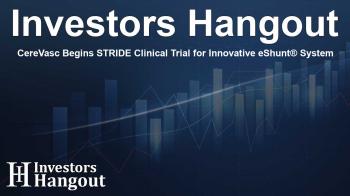CereVasc Begins STRIDE Clinical Trial for Innovative eShunt® System

CereVasc Kicks Off STRIDE Clinical Trial for eShunt® System
In a significant advancement for neurological treatment, CereVasc, Inc. has initiated its STRIDE clinical trial, marking the enrollment of the first patient using the eShunt System to treat Normal Pressure Hydrocephalus (NPH). This pivotal study is designed to evaluate the safety and efficacy of the eShunt System compared to conventional ventriculo-peritoneal (VP) shunts, a procedure that has been standard for over 70 years.
Highlighting the STRIDE Clinical Trial
The STRIDE trial is multi-centered and randomized, bringing together a diverse range of clinical sites committed to improving patient outcomes. This trial can be described as a response to the pressing medical needs of elderly individuals diagnosed with NPH, also identified as Hakim's Disease. The outcomes of this study will be instrumental for CereVasc as they prepare to submit for Premarket Approval (PMA) to the FDA.
The Need for Innovative Solutions
Dr. Charles Matouk, a leading figure in the neurosurgical community, emphasized the enthusiasm surrounding this trial. He stated, "The groundswell of excitement amongst patients and in the medical community highlights the urgent need for innovative treatments. Many patients express fear regarding traditional open neurosurgery, making a minimally invasive approach appealing." This sentiment is echoed throughout the healthcare industry as the search for less invasive treatment options continues.
Advantages of the eShunt System
The eShunt System is notably distinct, being the only endovascular shunt developed specifically for NPH. With approximately 800,000 cases of NPH reported in the US, many individuals are often seen as unsuitable for traditional surgical interventions due to age or fragile health conditions. The eShunt System offers a revolutionary alternative that could enhance the quality of life for these patients.
A Transformative Approach to Surgery
Dr. Pedro Lylyk, a co-lead investigator in this study, adds, "This innovative system is paving the way for a new era of neurosurgery, emphasizing shorter, less invasive procedures. This not only improves patient eligibility but encourages more individuals to consider treatment." This highlights a crucial shift in medical practice, where patient comfort and safety are prioritized.
Significance of the STRIDE Trial for the Future
Dan Levangie, the Chairman and CEO of CereVasc, described the opening of enrollment for the STRIDE trial as a significant milestone. He stated, "This study uniquely compares a less invasive method against traditional surgical approaches for treating NPH. The feedback from patients seeking alternatives emphasizes the importance of this research in the quest for effective and safer treatment options."
About CereVasc, Inc.
CereVasc, Inc. is strategically located in a healthcare hub known for its commitment to innovation. As a clinical-stage company, their focus remains on developing minimally invasive solutions for neurological diseases. The eShunt System represents a significant leap forward, aimed at allowing percutaneous transvenous-transdural access to the central nervous system, which is a groundbreaking methodology.
Looking Ahead: The Potential of the eShunt Device
This investigational device is designed to treat communicating hydrocephalus without necessitating invasive surgery, a prospect that brings hope to many who have been sidelined by current treatments. CereVasc's innovative approach reflects a broader trend in medicine towards less invasive solutions that prioritize patient comfort and quicker recovery times.
Frequently Asked Questions
What is the purpose of the STRIDE clinical trial?
The STRIDE clinical trial aims to evaluate the safety and efficacy of the eShunt System in treating Normal Pressure Hydrocephalus compared to traditional VP shunts.
Who can participate in the STRIDE clinical trial?
The trial is focused on elderly patients diagnosed with Normal Pressure Hydrocephalus, particularly those who may not be ideal candidates for traditional surgery.
What are the key benefits of the eShunt System?
The eShunt System is designed to provide a less invasive treatment option, which could greatly improve patient recovery time and overall quality of life.
How is CereVasc contributing to neurosurgery innovation?
CereVasc is developing novel treatments that emphasize minimally invasive techniques, which reflect the ongoing evolution in neurosurgical practices.
What does the future hold for the eShunt Device?
As research continues, the eShunt Device has the potential to transform standard care practices for treating hydrocephalus, enhancing both safety and efficacy for patients.
About Investors Hangout
Investors Hangout is a leading online stock forum for financial discussion and learning, offering a wide range of free tools and resources. It draws in traders of all levels, who exchange market knowledge, investigate trading tactics, and keep an eye on industry developments in real time. Featuring financial articles, stock message boards, quotes, charts, company profiles, and live news updates. Through cooperative learning and a wealth of informational resources, it helps users from novices creating their first portfolios to experts honing their techniques. Join Investors Hangout today: https://investorshangout.com/
Disclaimer: The content of this article is solely for general informational purposes only; it does not represent legal, financial, or investment advice. Investors Hangout does not offer financial advice; the author is not a licensed financial advisor. Consult a qualified advisor before making any financial or investment decisions based on this article. The author's interpretation of publicly available data shapes the opinions presented here; as a result, they should not be taken as advice to purchase, sell, or hold any securities mentioned or any other investments. The author does not guarantee the accuracy, completeness, or timeliness of any material, providing it "as is." Information and market conditions may change; past performance is not indicative of future outcomes. If any of the material offered here is inaccurate, please contact us for corrections.
